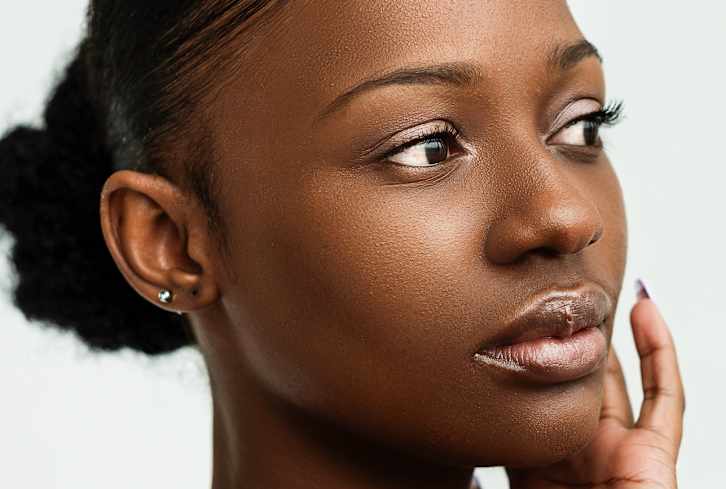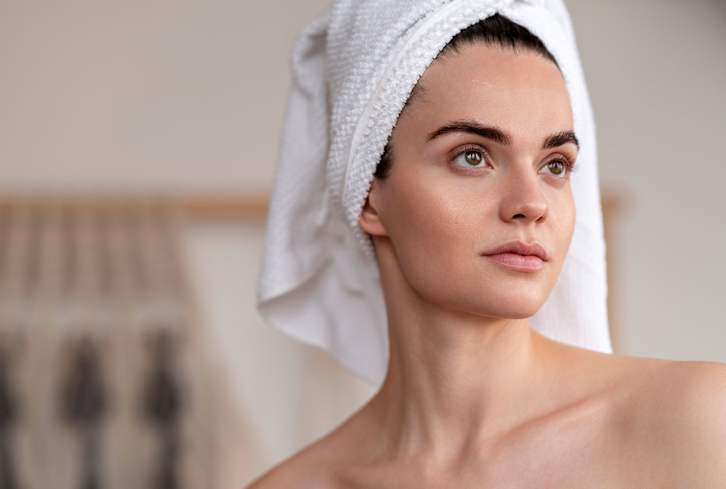Advertisement
Why We Should All Strive For Resilient Skin & How To Get It


I'm constantly looking for words to describe what healthy skin looks, feels, and acts like. Healthy skin is glowing! Healthy skin is balanced! Healthy skin means your barrier is strong! Healthy skin means you can do a minimal routine and it still looks vibrant! Healthy skin is all about longevity! And while all these are certainly true, it often feels like it falls short of what I'm actually trying to convey.
One descriptor I've been thinking more about is that healthy skin is resilient. Resiliency is the ability to withstand and recover. As physician and microbiome expert Larry Weiss, M.D., once told me, "It's the ability to bend without breaking."
Resiliency is not only an indicator of healthy skin but the definition of healthy skin.
What resilient skin looks like
Maybe, somewhere in the Multiverse of Wellness, there exists a version of you that always gets eight hours of sleep, hits their step goals, makes the workout class with time to spare, has never felt anxiety, eats their balance of micros and macros, and has never missed a step in their skin care routine. Maybe that's the version of you that's reading this right now!
Or maybe it's not—and instead, like me, you struggle with taking care of yourself sometimes. Not adhering to perfect habits every single day is not a failure but a fact of life.
Viewing skin health through the lens of resiliency allows for the simple and undeniable fact that, well, life happens. An obvious statement, sure, but I often worry about the fact that we don't allow life to show up on our skin.
Take, for example, laugh lines—the etches that form around your nasolabial folds. Wrinkles happen as we age, due to the natural decline in things like collagen, elastin, fat, bone, and muscle. They can be exacerbated by damage (what we don't want), but ultimately they're inevitable. And that's OK—to age means to live, and may we all be so lucky. Even just the moniker of "laugh" lines should at least give an indication that these developed from happy days.
So, to think of developing wrinkles is an indication that skin has failed its job—that it's unhealthy—is a complete denial of what skin's function is. The skin is there to protect you from external stressors, hold in what's necessary, and act as a visual communicator of what's happening internally. And in fulfilling this role, the skin will change, adapt, and react with time. Some of those changes may come as a result of wrinkles.
Another example is acne. As someone who dealt with breakouts for the better part of two decades, I can understand the urgency with which you want to "fix" the problem. But pimples are a symptom, not the root cause in and of itself. Acne is a complex, multifactorial skin condition that arises due to an imbalance of the skin microbiome, the gut, overall inflammation in the body, hormones, and external factors (like the wrong topical products).
Pimples are your skin's way of telling you that something is off in the body. "By the time we see symptoms manifesting at the surface, that means there's a chronic history of issues going on internally. It takes time to heal—often, more time than we want it to," says famed holistic esthetician Kristina Holey.
Compare it to putting too much pressure on the body to keep on going during times of stress. At some point, your body is going to signal to you that it needs rest. And in those moments, our health may not be the picture of perfection—we may feel exhausted, burnt out, or even sick.
But resilience isn't just demonstrated when the body is able to withstand, it's demonstrated when the body is in recovery too. The ability to bounce back from stress is just as strong of a signifier of health—if not more so—than the unrealistic ability to avoid it altogether.
That's how we should view our skin: Healthy skin isn't always perfect, but it is capable of recovery.
How to achieve resilient skin
The best way to get resilient skin is to listen to it. We often talk about how it's important to listen to your body, and your skin is no different.
Listening to your skin means that you have to get to know it. Pay attention to how it changes due to external stressors, is influenced by lifestyle choices, and reacts to products. It also means making skin care choices based on that knowledge. "Intuitive skin care" is a style of skin care that means you make choices based on the needs of your skin at that time.
Rather than feeling obligated to stick to a strictly set three-step routine, this allows for a more dynamic approach to skin: One that will utilize a soothing cream when your skin is feeling sensitive, or an exfoliating number when you feel you need a boost.
The products you do use, too, should be sophisticatedly formulated. Look for ingredients that complement the skin structure.
For example, ceramides are polar lipids naturally found in the skin—but research shows that stressed skin has less naturally and can decline with age, too. You can apply ceramides topically to help bolster your own supply. Shea butter, for example, has similar topical effects as ceramides1.
Hyaluronic acid is another humectant produced by the body that declines as we get older. It has an astounding ability to attract and hold water in the skin. With its decline, our skin has trouble staying hydrated and may appear less supple. Luckily, it's a common ingredient in many serums, face creams, and lip balms.
Vitamin C is another excellent example of an ingredient that complements the skin. We do not make it naturally, but our bodies need it in the collagen synthesis process, so we have to get it from external sources if we want to support collagen production. You can find it in vitamin C serums, or it is found naturally in many botanical ingredients like mango seed butter and berry extracts.
On the subject of nutrients our body doesn't produce on its own: Essential fatty acids are lipids that are essential for skin function but not inherent to the lipid layer—so again, we must look to external sources. Lots of botanical oils contain omega-3 and -6 fatty acids, such as safflower seed oil, sunflower seed oil, rosehip seed oil, and grapeseed oil.
You also want to ensure you're taking care of your microbiome—your skin's first line of defense. The microbiome is the ecosystem of organisms that live on our skin, providing a protective buffer, communicating with our immune system, producing nutrients, and keeping the skin balanced. Without a thriving skin microbiome, our skin and body suffers. The best thing you can do for your microbiome is to feed it topical pre- and postbiotics. These are non-living organisms that help nurture and balance the microbiome.
Finally, be mindful not to strip the skin of its protective elements. Resilient skin is only possible when skin has the power of self-preservation. And when we over-exfoliate, use harsh ingredients, and strip it of its natural moisture barrier, we're essentially taking away the element that makes skin able to withstand stress in the first place.
The takeaway
Your skin is not siloed from the world around you. Skin reacts and changes due to life—but you also have a lot of power in this situation. You can help your skin become stronger and more resilient by feeding it the nutrients it needs and strengthening the barrier. But to do this, you need to pay attention to it—listen to its signals that it's under duress, and allow it grace during times of stress.
Watch Next
Enjoy some of our favorite clips from classes
Enjoy some of our favorite clips from classes
What Is Meditation?
Mindfulness/Spirituality | Light Watkins
Box Breathing
Mindfulness/Spirituality | Gwen Dittmar
What Breathwork Can Address
Mindfulness/Spirituality | Gwen Dittmar
The 8 Limbs of Yoga - What is Asana?
Yoga | Caley Alyssa
Two Standing Postures to Open Up Tight Hips
Yoga | Caley Alyssa
How Plants Can Optimize Athletic Performance
Nutrition | Rich Roll
What to Eat Before a Workout
Nutrition | Rich Roll
How Ayurveda Helps Us Navigate Modern Life
Nutrition | Sahara Rose
Messages About Love & Relationships
Love & Relationships | Esther Perel
Love Languages
Love & Relationships | Esther Perel
What Is Meditation?
Box Breathing
What Breathwork Can Address
The 8 Limbs of Yoga - What is Asana?
Two Standing Postures to Open Up Tight Hips
How Plants Can Optimize Athletic Performance
What to Eat Before a Workout
How Ayurveda Helps Us Navigate Modern Life
Messages About Love & Relationships
Love Languages
Advertisement

We Need To Talk About Toxic Femininity In Beauty: Ever Encounter These Examples?
Perpetua Neo, DClinPsy

We Need To Talk About Toxic Femininity In Beauty: Ever Encounter These Examples?
Perpetua Neo, DClinPsy

We Need To Talk About Toxic Femininity In Beauty: Ever Encounter These Examples?
Perpetua Neo, DClinPsy

We Need To Talk About Toxic Femininity In Beauty: Ever Encounter These Examples?
Perpetua Neo, DClinPsy
-v1646695196476.jpg?1148x800)












